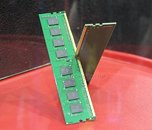Tuesday, June 3rd 2014

GeIL DDR4 Memory Smiles for the Camera
GeIL showed off its first DDR4 memory module, which will serve as a common platform for a number of the company's consumer memory lines. Depending on the DRAM chip density, the module will come in capacities of 4 GB, 8 GB, and 16 GB. The module voltage will stay at 1.2V, and it will come in clock speeds of 1600 MHz (CL 10~12), 1866 MHz (CL 12~14), 2133 MHz (CL 14~16), 2400 MHz (CL 15), 2666 MHz, and 3200 MHz. GeIL will craft out several models based on this common PCB.

3 Comments on GeIL DDR4 Memory Smiles for the Camera
I do not see any point in DDR4 clocked under 3 GT/s.
I don't recall ever seeing lower voltage (or the same voltage) with better timings and higher frequencies right out of the gate with new memory. Performance is often on par (plus or minus) with the previous gen and typically costs more. No one has to worry about it though unless they plan on building a new Haswell-E based system in the second half of 2014.
I have tentative plans to do so. Therefore I may have to contend with this.
DDR4 is primarily for servers and offers almost nothing over DDR3 ULV. Most servers still run RAM at ~1600 MHz.
Extensive testing has shown that DDR3 running at 1600+ MHz. is not a system bottleneck on desktop PCs with discrete CPUs thus faster RAM shows no tangible system performance gains. With APUs the GPU section benefits up to RAM frequencies of ~2133 MHz. and then tappers off. Actual latency differences on RAM running at 1600+ MHz. has even less system performance impact than the frequency thus you can't tell any diff in system performance from CL 11 vs. CL 14. This has all been documented with real apps. The RAM benchmarking programs grossly exaggerate the frequency and latency changes because they assume the RAM to be saturated 100% of the time which it never is.
The DDR4 hype is to get gullible PC fans to buy new RAM they don't need and that won't provide any tangible system performance gain.